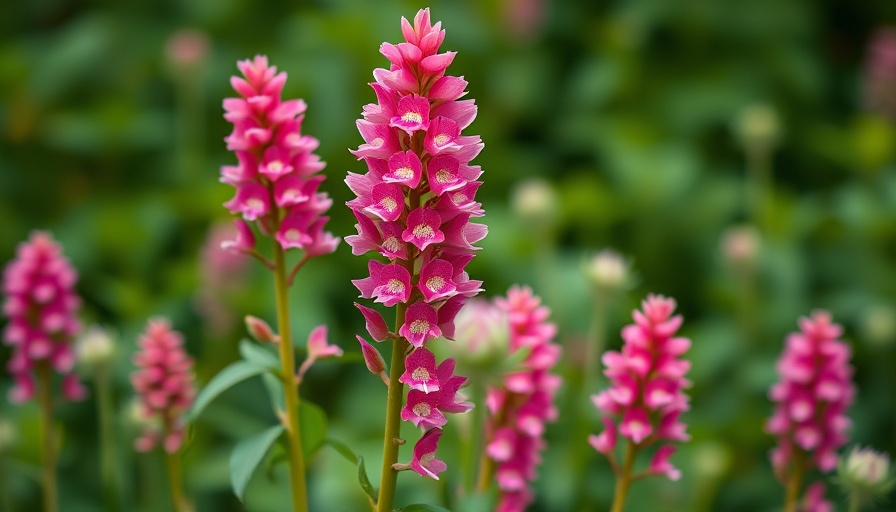
Unveiling the Beauty of Turtlehead Flowers
The Turtlehead flower (Chelone spp.) stands out as an exquisite addition to any garden, particularly in moisture-rich landscapes. Native to eastern North America, this lesser-known perennial has only recently gained traction within the horticultural community. Renowned for its ability to thrive in less-than-ideal conditions, Turtlehead not only enhances a boring flowerless spot but also plays a vital role in supporting local wildlife.
Quick Overview of Turtlehead Varieties
There are three primary species to consider: Chelone glabra, known for its brilliant white flowers; C. lyonii, which features captivating pink blooms; and C. obliqua, a robust species often threatened in the wild that displays vivid pink to red flowers. Each of these species can grow up to three feet tall, making them striking vertical elements in your landscape.
Growing Conditions: Your Guide to Success
When preparing to cultivate Turtlehead flowers, understanding their preferred conditions is critical. They flourish in USDA Hardiness Zones 3-9, demonstrating resilience against pests and diseases.
- Sun Exposure: While these plants can tolerate both full sun and partial shade, they thrive best with about four hours of sunlight every day. For those in the warmer zones, providing some shade can help manage their hydration levels.
- Soil Preferences: Turtlehead requires rich, moist soil with a slightly acidic to neutral pH (between 6.0 and 7.0). Well-draining yet organically rich soil guarantees healthy growth.
- Watering Strategies: To ensure robust development, keep the soil consistently moist, especially during the first season. During drier spells, regular watering is crucial to avoiding stress on the plants.
Benefits of Growing Turtlehead
Beyond mere aesthetics, Turtlehead flowers offer numerous ecological benefits:
- Pollinator Magnet: Their nectar-rich flowers attract a variety of pollinators, including bees, butterflies, and hummingbirds, making them an excellent choice for promoting biodiversity in your garden.
- Medicinal Qualities: Many cultures have used Turtlehead for its medicinal properties, historically linking it to liver health and digestive support, thanks to its composition of iridoid glycosides.
- Low Maintenance: Turtleheads are low-maintenance champions, requiring minimal care while still delivering a long blooming period from late summer into fall. For gardeners looking for beauty without added labor, they are a perfect choice.
Tips for Successful Propagation
Turtlehead plants are easily propagated through division and seeds. To enhance your garden's diversity, consider planting a mix of species. Here are some tips to ensure successful propagation:
- Division Timing: The best time to divide your Turtlehead plants is early spring or in the fall—remember to keep the new divisions well-watered until they establish.
- Growing from Seed: Start seeds indoors in early spring for a tasty bonus of home-grown Turtlehead. Ensure they get plenty of light and keep the soil moist to promote germination.
Common Challenges and Solutions
While Turtlehead plants are generally resilient, they can face certain challenges:
- Flopping Stems: If stems appear weak, moving the plants to a sunnier location or staking them can help provide the necessary support.
- Powdery Mildew: This condition often arises due to high humidity. Maintaining even moisture levels and watering at the base can greatly reduce the risk.
Incorporating Turtlehead into Garden Design
Not only is Turtlehead a functional plant offering wildlife benefits, but it also serves as a stunning addition to landscaping. Whether included in rain gardens, cottage-style, or wildlife-inspired gardens, its unique flowers and captivating presence enhance your outdoor space. To maximize its impact, position it along water features or in moist areas where it can thrive best.
In Conclusion: The Elegance of Turtlehead Flowers
In the age of environmental awareness and the yearning for biodiversity, Turtlehead flowers shine as an easy-to-care-for, beautiful option for gardeners. As they bloom in splashes of white, pink, and vibrant hues, they provide not only visual appeal but also essential support for local ecosystems. Consider adding Turtlehead to your flower beds and experience the stunning beauty and benefits this plant has to offer.
 Add Row
Add Row  Add
Add 




Write A Comment